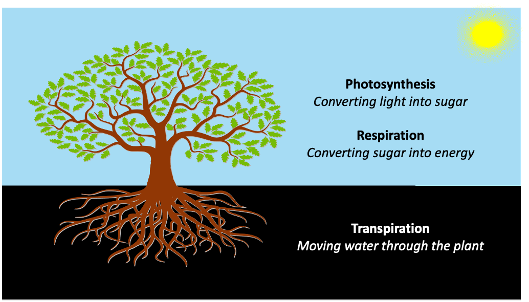The basics: plants and soil
Plants are incredible. They are living machines that convert the simplest of substances into a bewildering array of complex molecules that form the basis for almost all non-microbial life on earth. They do this in partnership with a rich ecosystem of microscopic lifeforms, which transform lifeless mineral dirt into thriving, wonderful soil.
The processes by which this happens are too complicated for a single blog article. This post aims only to provide a very high level overview of topics that we will explore in much more detail in other articles.
Three basic processes
Plants achieve this miraculous feat through three basic processes:
Photosynthesis: the process by which carbon dioxide and water in the atmosphere are converted into glucose (a simple type of sugar) in the presence of sunlight, producing oxygen as a waste product.
Respiration: the process by which the glucose produced by photosynthesis is combined with oxygen from the atmosphere to produce energy for the plant, producing carbon dioxide and water as waste products.
Transpiration: the process by which water, containing dissolved substances from the soil, is taken up by the plant’s roots and transported throughout the plant.
Photosynthesis and respiration are ancient processes that evolved even before plants existed. As they themselves evolved, plants captured ancient microbes and made them part of their own tissues. We can see this as the essential structures within the plants that enable these processes (“chloroplasts” for photosynthesis, and “mitochondria” for respiration) have genetic material that is distinct from that of the plant itself.
17 essential nutrients
When we talk about nutrients for animals (including humans), we mean complex substances such as vitamins and minerals, fats, proteins and carbohydrates. All of these are built from simpler substances that are produced by plants (some are put together within the bodies of animals as they process the food they eat, others are made directly within plants themselves).
When we talk about nutrients for plants, we mean something different, something much simpler. Nutrients for plants are the elements of chemistry, the simplest substances possible. These can be thought of in four groups, based on how plants obtain them, and how much of each is needed by a typical plant. “Macronutrients” are needed by plants in large quantities, whereas “micronutrients” are needed only in tiny amounts. “Non-mineral nutrients” are taken up by plants from the air and from water; other nutrients are “mineral nutrients”, obtained from the soil (the word “mineral” is usually dropped when talking about these).
Non-mineral macronutrients: carbon (chemical symbol C), hydrogen (H) and oxygen (O) are taken up by plants from the air and from water
Primary macronutrients: nitrogen (N), phosphorus (P) and potassium (K)
Secondary macronutrients: calcium (Ca), magnesium (Mg) and sulphur (S)
Micronutrients: iron (Fe), boron (B), chlorine (Cl), manganese (Mn), zinc (Zn), copper (Cu), molybdenum (Mo), nickel (Ni) are considered to be essential for all plants, with up to 90 elements in total being used in trace amounts by specific plants.
Some of the essential mineral nutrients are found freely in soil in a form that plants can use. Others need to be extracted from the material that makes up the soil itself. This is accomplished by bacteria and fungi, microscopic organisms that live in the soil. These microbes break down the soil material and incorporate nutrients into their own tissues, excreting excess mineral nutrients in a plant available form. They are also preyed upon by other organisms in a complex food web; the waste products produced by these predators also contain plant available nutrients.
One complex interactive system
We can now put everything together into a simple overview of how plants do what they do.
Plants take in non-mineral macronutrients from the air in the form of carbon dioxide (CO₂) and water (H₂O). Using energy from sunlight, they convert these into sugar through the process of photosynthesis. Using oxygen (O₂), also taken in from the air, they produce energy through the process of respiration. This energy is used to power all the processes that take place within the plant.
Microscopic organisms live in the soil and transform soil material into mineral nutrients, which dissolve into water in the soil. Plants take up this water, with its dissolved nutrients, through their roots, and transport it to where the nutrients are needed through the process of transpiration. Within the tissues of the plant, nutrients are combined in chemical reactions to produce more complex substances, which are used by the plant for a huge range of different purposes, such as growth, reproduction, defence against herbivores, competition with other plants etc
There’s much much more…
This is a very simple overview of a very complex set of systems and processes. Over time, Getting Dirty will dig deeper into many aspects of these (occasionally in excruciating detail…). We will also consider what the underlying science means for how we look after our outdoor spaces, our soil and our plants; the characteristics of specific plants and how we can use them in our gardens (including how we can best look after them); and how we can use not only plants, but also other features of our gardens to create spaces that are both beautiful and functional (digging deeper into how and why we can achieve these goals).
It’s an exciting journey ahead… let’s Get Dirty!

